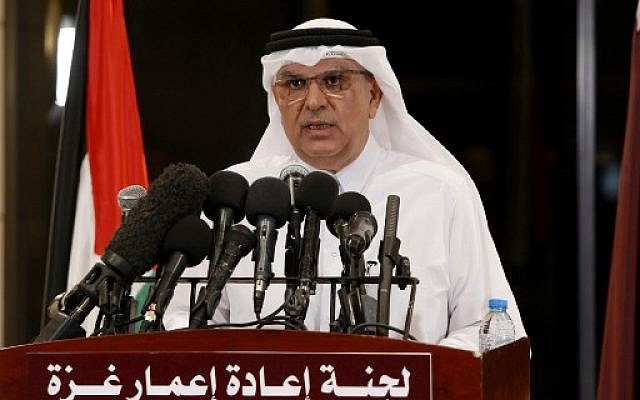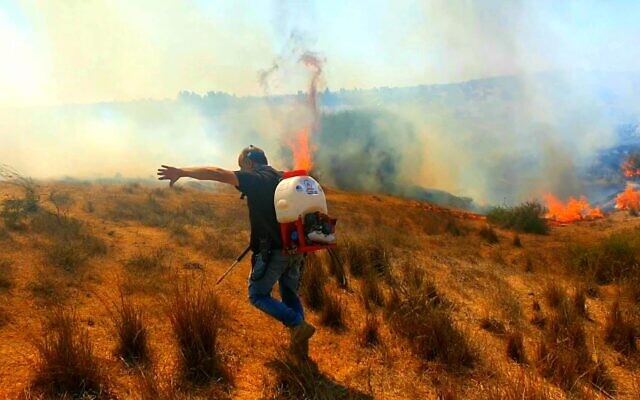Gaza arson balloons spark 33 fires in south while Qatar envoy still in Strip
Two incendiaries land inside communities, one near a playground where children were playing
Palestinians in Gaza lofted airborne incendiary devices that sparked 33 fires in southern Israel Wednesday while Qatar’s envoy to the Hamas-run coastal enclave was still in the Strip seeking to deescalate ongoing tensions between the terror group and Israel.
Two of the arson balloons landed within the borders of a community in the Eshkol Regional Council, with one falling near a playground where children were playing and another coming down near a home belonging to elderly residents, a spokesman for the municipality said.
However, most of the brush fires caused were “small and not dangerous,” the Israel Fire and Rescue Services said in a statement.
Israeli warplanes and tanks attacked Hamas targets in southern Gaza earlier Wednesday after balloon launchers caused 29 fires near border towns on Tuesday.
Those fires followed 36 on Monday, 28 on Sunday and 35 the day before, according to the fire department.
The latest fires came as Qatari envoy Mohammed al-Emadi was still in the Gaza Strip, where he arrived late Tuesday night bringing $30 million in cash, seeking to ease the Israel-Hamas tensions that have led to daily arson balloon and rocket attacks on Israel and IDF reprisal strikes.
The money is earmarked to help the territory of two million people, half of whom live under the poverty line, sources close to the envoy told AFP.
Al-Emadi met with Hamas officials later Tuesday night.
His arrival came a day after the London-based Arabic-language daily Asharq al-Awsat reported that the head of the IDF Southern Command, Maj. Gen. Herzi Halevi, visited Qatar this week in a bid to secure a ceasefire agreement with Hamas.
The terror group is under immense international pressure from Qatar, Egypt and UN envoy Nickolay Mladenov to halt its attacks, alongside pressure from the Gazan public, which is getting only three to four hours of electricity per day after becoming used to more than three times that amount. The power shortages are a result of Israel stopping fuel imports in response to the violence, which led a Gaza power plant to shut down.
The uptick in violence along the border is thought to be linked to demands for increased cash transfers from Qatar to the Strip, where around 60 percent of the population is unemployed.
In recent days the IDF has responded to dozens of daily arson balloons and intermittent rocket fire with near-nightly reprisal strikes on Hamas targets in the Strip, including underground infrastructure, weapons production facilities, cement factories used to make parts for tunnels, and observation posts along the border.

On Monday, a senior Hamas official told the pro-Hamas channel Palestine Today that the surge in violence would continue until the terror group’s demands on lifting the blockade were met.
“It is our right to break this siege,” Ismail Radwan said.
Israel and Egypt have maintained a blockade on Gaza since Hamas ousted the Palestinian Authority in 2007. The blockade, Israel says, is meant to prevent Hamas from importing weapons, as well as material used to construct fortifications and underground tunnels. Israel also frequently tightens restrictions on the Gaza Strip to put pressure on Hamas or in response to violence emanating from it.
Israel has shuttered its only commercial crossing into the Gaza Strip, allowing only food, medication and humanitarian aid to pass. Israel also closed the fishing zone around the coastal enclave.
Qatari delegation sources said the Israeli side had told al-Emadi that it is prepared to allow the power station to refuel and ease restrictions in exchange for a return to calm and an end to the incendiary balloons.
On Monday, a coalition of Gaza-based terror groups threatened to attack Israeli forces if the ban on fishing — a major industry in the Strip — continued.
“We will not allow the enemy to behave horribly towards our people’s fishermen, and encroach upon their livelihoods and rob them. We will defend them and work to protect them,” said the so-called Joint Operations Room.





No comments:
Post a Comment